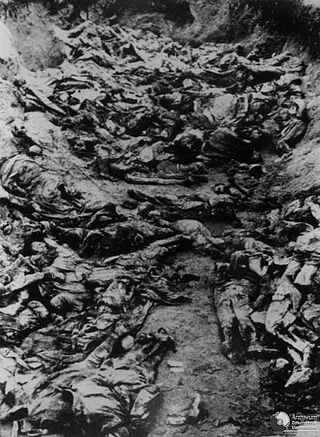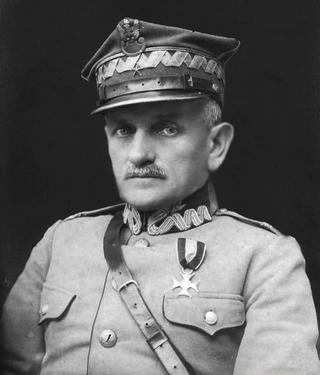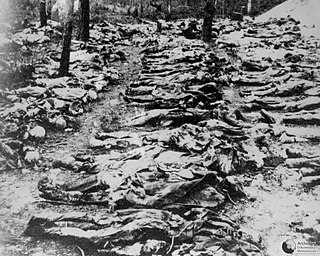Related Research Articles

Katyn is a rural locality in Smolensky District of Smolensk Oblast, Russia, located approximately 20 kilometers (12 mi) to the west of Smolensk, the administrative center of the oblast. The village had a population of 1,737 in 2007.

Konstanty Plisowski of Odrowąż was a Polish general and military commander. He was the Commander in the battle of Jazłowiec and the battle of Brześć Litewski. He was murdered on Stalin's orders in the Katyn massacre.

Stanisław Haller de Hallenburg was a Polish politician and general who was murdered in the Katyn massacre. He was a cousin of General Józef Haller von Hallenburg.

Brigadier General Mieczysław Makary Smorawiński (1893–1940), was a Polish military commander and officer of the Polish Army. He was one of the Polish generals identified by forensic scientists of the Katyn Commission as the victim of the Soviet Katyn massacre of 1940.

Stanisław Swianiewicz was a Polish economist and historian. A veteran of the Polish-Soviet War, he was during World War II a survivor of the Katyn massacre and an eyewitness of the transport of Polish prisoners-of-war to the forests outside Smolensk by the NKVD.

Leon Billewicz was a Polish officer and a General of the Polish Army. He was murdered during the Katyń massacre.

Bronisław Bohatyrewicz of Ostoja was a Polish military commander and a general of the Polish Army. Murdered during the Katyn massacre, Bohatyrewicz was one of the Generals whose bodies were identified by forensic scientists of the Katyn Commission during the 1943 exhumation.

Henryk Minkiewicz was a Polish socialist politician and a general of the Polish Army. Former commander of the Border Defence Corps, he was among the Polish officers murdered in the Katyń massacre.

Kazimierz Orlik-Łukoski was a Polish military commander and one of the Generals of the Polish Army murdered by the Soviet Union in the Katyń massacre of 1940.

Rudolf Prich was a Polish military officer and a major general of the Polish Army. He was among the Polish officers who were murdered by the Soviet Union during the Katyń massacre.

Piotr Skuratowicz was a Polish military commander and a General of the Polish Army. A renowned cavalryman, he was arrested by the NKVD and murdered in the Katyn massacre.

Katyn war cemetery is a Polish military cemetery located in Katyn, a small village 22 kilometres away from Smolensk, Russia, on the road to Vitebsk. It contains the remnants of 4,412 Polish officers of the Kozelsk prisoner of war camp, who were murdered in 1940 in what is called the Katyn massacre. Except for bodies of two Polish generals exhumed by German authorities in 1943 and then buried separately, all Polish officers murdered in Katyn were buried in six large mass graves. There is also a Russian part of the cemetery, where some 6,500 victims of the Soviet Great Purges of the 1930s were buried by the NKVD. The cemetery was officially opened in 2000.

Ray John Madden was an American lawyer and World War I veteran who served 17 terms as a United States representative from Indiana from 1943 to 1977.

The Katyn massacre was a series of mass executions of nearly 22,000 Polish military officers and intelligentsia prisoners of war carried out by the Soviet Union, specifically the NKVD in April and May 1940. Though the killings also occurred in the Kalinin and Kharkiv prisons and elsewhere, the massacre is named after the Katyn forest, where some of the mass graves were first discovered by German Nazi forces.

Józef Czapski was a Polish artist, author, and critic, as well as an officer of the Polish Army. As a painter, he is notable for his membership in the Kapist movement, which was heavily influenced by Cézanne. Following the Polish Defensive War, he was made a prisoner of war by the Soviets and was among the very few officers to survive the Katyn massacre of 1940. Following the Sikorski-Mayski Agreement, he was an official envoy of the Polish government searching for the missing Polish officers in Russia. After World War II, he remained in exile in the Paris suburb of Maisons-Laffitte, where he was among the founders of Kultura monthly, one of the most influential Polish cultural journals of the 20th century.
As a result of the Soviet invasion of Poland in 1939, hundreds of thousands of Polish soldiers became prisoners of war. Many of them were executed; 22,000 Polish military personnel and civilians perished in the Katyn massacre alone.

Leonard Wilhelm Skierski was a Polish military officer. He was a general of the Imperial Russian Army and then served in the Polish Army. He fought in World War I and in the Polish–Soviet War. He was one of fourteen Polish generals and one of the oldest military commanders to be murdered by the NKVD in the Katyn massacre of 1940.

François Naville was a Swiss physician and director of the medico-legal Institute of the University of Geneva. He was the only truly neutral expert participating in the international Katyn Commission investigating the Soviet Katyn massacre of some 22,000 Polish prisoners of war, mostly Polish Army officers, who had been arrested and imprisoned in the course of the Soviet and German invasion of Poland. Their bodies were discovered in a series of large mass graves in the forest near Smolensk in Russia following the Nazi German Operation Barbarossa.

Anti-Katyn is a denialism campaign intended to reduce and obscure the significance of the Katyn massacre of 1940 — where approximately 22,000 Polish officers were murdered by the Soviet NKVD on the orders of Joseph Stalin — by referencing the deaths from disease of thousands of Imperial Russian and Red Army soldiers at Polish internment camps during the Interwar period.

The Katyn Commission or the International Katyn Commission was a committee formed in April 1943 under request by Germany to investigate the Katyn massacre of some 22,000 Polish nationals during the Soviet occupation of Eastern Poland, mostly prisoners of war from the September Campaign including Polish Army officers, intelligentsia, civil servants, priests, police officers and numerous other professionals. Their bodies were discovered in a series of large mass graves in the forest near Smolensk in Russia following Operation Barbarossa.
References
- 1 2 Fischer, Benjamin B. "The Katyn Controversy: Stalin's Killing Field" Studies in Intelligence Winter, 1999–2000.
- 1 2 3 4 5 6 7 8 "Records Relating to the Katyn Forest Massacre at the National Archives". National Archives. Retrieved 7 April 2017.
 This article incorporates text from this source, which is in the public domain .
This article incorporates text from this source, which is in the public domain .
- United States. Congress. House. Select Committee to Conduct an Investigation and Study of the Facts, Evidence, and Circumstances on the Katyn Forest Massacre. The Katyn Forest Massacre: Hearings Parts 1-4 Parts 5-7 Before the Select Committee to Conduct an Investigation of the Facts, Evidence And Circumstances of the Katyn Forest Massacre, Eighty-second Congress, First-[second] Session, On Investigation of the Murder of Thousands of Polish Officers In the Katyn Forest Near Smolensk, Russia. Washington: U.S. Govt. Print. Off, 1952.
- United States. Congress. House. Select Committee to Conduct an Investigation and Study of the Facts, Evidence, and Circumstances on the Katyn Forest Massacre. The Katyn Forest Massacre: Interim Report of the Select Committee to Conduct an Investigation of the Facts, Evidence And Circumstances of the Katyn Forest Massacre Pursuant to H. Res. 390 And H. Res. 539, Eighty-second Congress, a Resolution to Authorize the Investigation of the Mass Murder of Polish Officers In the Katyn Forest Near Smolensk, Russia. Washington: U. S. Govt. Print. Off., 1952.
- United States. Congress. House. Select Committee to Conduct an Investigation and Study of the Facts, Evidence, and Circumstances on the Katyn Forest Massacre. The Katyn Forest Massacre: Final Report of the Select Committee to Conduct an Investigation of the Facts, Evidence And Circumstances of the Katyn Forest Massacre Pursuant to H. Res. 390 And H. Res. 539, Eighty-second Congress, a Resolution to Authorize the Investigation of the Mass Murder of Polish Officers In the Katyn Forest Near Smolensk, Russia. Washington: U. S. Govt. Print. Off., 1952.
![]() This article incorporates public domain material from websites or documents of the National Archives and Records Administration .
This article incorporates public domain material from websites or documents of the National Archives and Records Administration .